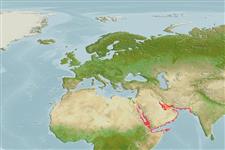Environment: milieu / climate zone / depth range / distribution range
Ecología
marino asociado a arrecife; rango de profundidad 5 - 50 m (Ref. 89707). Tropical; 29°N - 10°N, 32°E - 68°E (Ref. 5222)
Western Indian Ocean: Red Sea (including Gulf of Suez) and northwestern Indian Ocean to the coast of Pakistan. Specimens examined include those from the Gulf of Oman. Not reported from the Gulf of Aqaba nor from Persian Gulf.
Tamaño / Peso / Age
Maturity: Lm ? range ? - ? cm
Max length : 38.0 cm TL macho / no sexado; (Ref. 89707); common length : 35.0 cm TL macho / no sexado; (Ref. 5450)
Espinas dorsales (total): 11; Radios blandos dorsales (total): 16-18; Espinas anales 3; Radios blandos anales: 8. Body robust, preopercle with moderately enlarged serrae at its angle; upper edge of the operculum almost straight; nostrils subequal or posterior nostril slightly larger. Head and body yellowish gray, with dark orange-red or reddish brown spots except ventrally and posteriorly; dark gray bars running antero-ventrally from the base of the dorsal fin; a dark saddle blotch on the caudal peduncle. Fins generally yellowish brown; median fins with broad yellowish margin posteriorly (Ref. 89707).
Occurs on shallow sandy bottoms near small coral heads; it is not known from well-developed coral reefs (Ref. 5222). Nothing has been published on its biology nor its use in fisheries (Ref. 5222). Sold fresh in local markets (Ref. 5222).
Life cycle and mating behavior
Madurez | Reproducción | Puesta | Huevos | Fecundidad | Larva
Heemstra, P.C. and J.E. Randall, 1993. FAO Species Catalogue. Vol. 16. Groupers of the world (family Serranidae, subfamily Epinephelinae). An annotated and illustrated catalogue of the grouper, rockcod, hind, coral grouper and lyretail species known to date. Rome: FAO. FAO Fish. Synop. 125(16):382 p. (Ref. 5222)
IUCN Red List Status (Ref. 130435)
Threat to humans
Harmless
Human uses
Can't connect to MySQL database (fbapp). Errorcode: Too many connections
